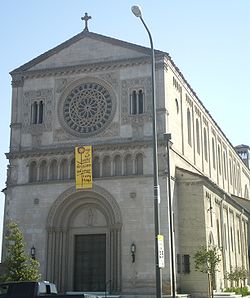| Saint John's Cathedral | |
|---|---|
| Saint John's Episcopal Cathedral | |
| Catedral Episcopal San Juan 聖約翰大教堂 세인트 존 성공회 대성당 | |
 | |
 | |
| Location | University Park, Los Angeles |
| Address | 514 W. Adams Blvd. Los Angeles, CA |
| Language(s) | Primarily English, readings might be performed in Spanish, Korean, Japanese, and Chinese. |
| Denomination | Episcopal Church |
| Associations | PGBM/Union of Black Episcopalians, GLEAM, PGHM EDLA, GAAPI, USC |
| Tradition | Central churchmanship |
| Churchmanship | Liberal Anglo-Catholicism and Broad church |
| Membership | 190-230(est.) |
| Weekly attendance | +190 |
| Website | www |
| History | |
| Former name(s) | Saint John's Church, St. John's Pro-Cathedral |
| Status | Active |
| Past bishop(s) | Rt. Rev. Jon Bruno Rt. Rev. Diane Jardine Bruce. |
| Architecture | |
| Functional status | Cathedral |
| Previous cathedrals | St Pauls Cathedral(demolished) |
| Administration | |
| Province | Province 8 of the Episcopal Church |
| Metropolis | Greater Los Angeles |
| Diocese | Episcopal Diocese of Los Angeles |
| Deanery | Deanery 4 – El Centro |
| Clergy | |
| Bishop(s) | The Rt. Rev. John Harvey Taylor |
| Rector | None |
| Dean | The Very Rev. Anne Sawyer (Interim) |
| Canon(s) | Can. Earl Mounger Can. Lurelean Gaines Can. Karen Uhler |
| Priest in charge | Anne Sawyer |
| Priest(s) | Rev. Melvin Soriano |
| Assistant priest(s) | Rev. Lyn Crow |
| NSM(s) | Rev. Dr. Glenn M. Libby (ret.) Rev. Lee Walker (ret.) (Affiliated Priests) |
| Chaplain(s) | Melvin Soriano, USC Canterbury Chaplain |
| Deacon(s) | Rev. Margaret McCauley |
| Laity | |
| Organist(s) | Dr. Zach Neufeld |
| Churchwarden(s) | Can. Lurelean Gaines (Senior) & Nazario Palma(Junior) |
| Verger | Heyden Morales |
| Liturgy coordinator | Anne Sawyer |
| Flower guild | Martha Ree |
| Music group(s) | Dr. Christopher Gravis, Canon for Music Ministry and Cathedral Arts |
| Parish administrator | Kyle Black, Canon for Parish Administration |
| Sacristan | Heyden Morales & Sobhan Nouri (Sextons) |
St. John's Cathedral | |
 | |
| Location | 514 W. Adams Blvd Los Angeles, California |
|---|---|
| Coordinates | 34°1′38″N118°16′29″W / 34.02722°N 118.27472°W |
| Built | 1925 |
| Architect | Davis & Davis; Hanson, Luis |
| Architectural style | Romanesque Revival |
| NRHP reference No. | 00000425 [1] |
| LAHCM No. | 516 |
| Significant dates | |
| Added to NRHP | May 5, 2000 |
| Designated LAHCM | January 22, 1991 [2] |
St. John's Cathedral is an Episcopal church near downtown Los Angeles that serves as both a parish church and the cathedral church of the Episcopal Diocese of Los Angeles, an area covering five and a half counties. Though St. John's was formed in 1890, the current Romanesque Revival architectural style church was built in 1925. It was listed in the National Register of Historic Places in 2000.









